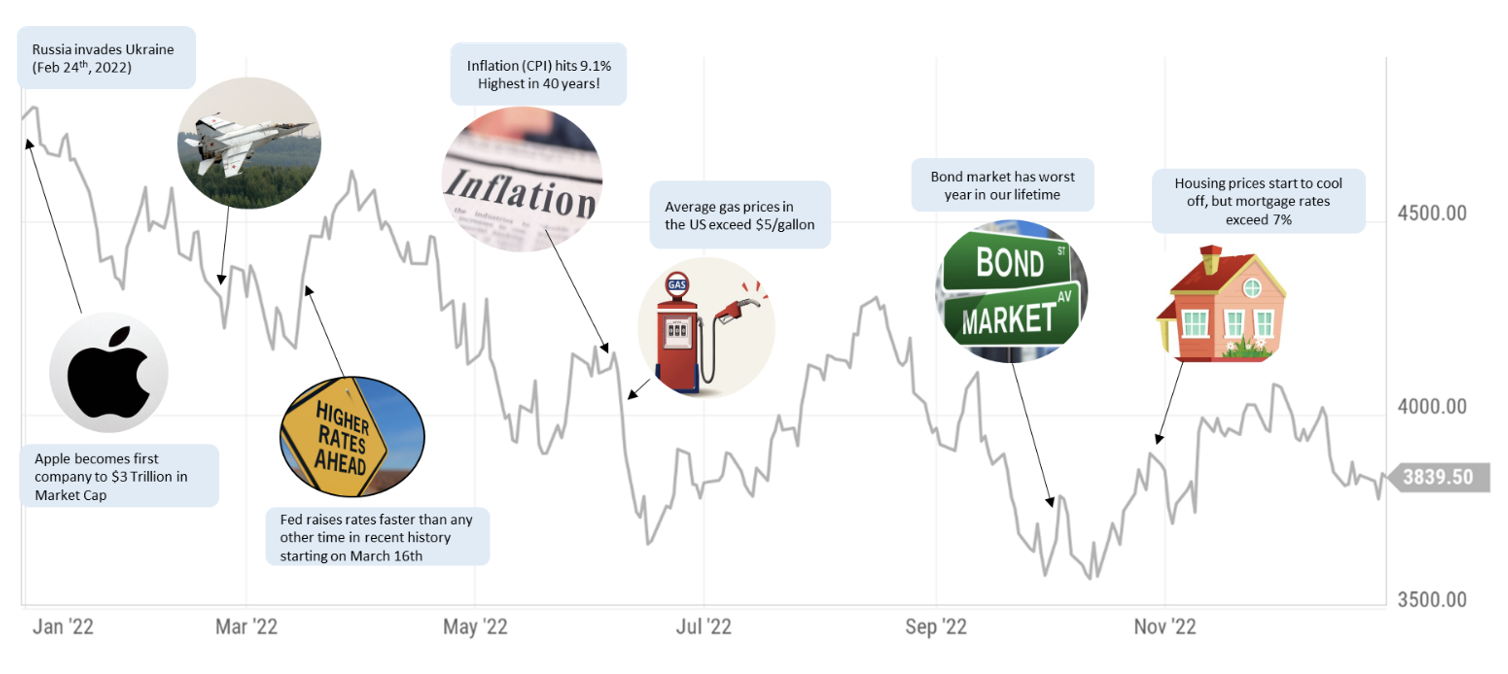
January 2023
Market Update
2022 Year in Review
By Jake Eggett
There are so many narratives that can be written about the markets as we look back on the year 2022. The first trading day of 2022 resulted in Apple becoming the first company in history to reach a valuation of $3 Trillion. (FYI - The first day of 2023 it fell below $2 Trillion.) The first week of the year the markets reversed course when the Fed minutes showed the transition of monetary policy was starting to take shape with tighter policies ahead. Geopolitical tensions escalated when Russia invaded Ukraine sending the market on a rollercoaster ride and crude prices rose to $130 barrel for the first time since 2008.
The unrelenting inflationary environment forced the Federal Reserve to aggressively raise interest rates to try and cool down prices. That ultimately created a shock throughout the global economic system that saw rapidly climbing bond yields, falling asset prices, and a pullback in risk appetites. With rising rates, the bond market had its worst year in our lifetimes and housing became more unaffordable with mortgage rates reaching 7%.
The year 2022 is likely to be remembered with anxiety by investors that lived through this upheaval in the financial system and the impact it had on their portfolios. The market performance section illustrates a sea of red that emphasizes just how few places there were to hide this year.
Market Performance
Even though the Fed has begun to slow their pace of rate hikes, which was not enough to spark a Santa Claus rally in December, downward pressure on the market may have partially been attributed to tax loss selling given the widespread losses that occurred this year. We would anticipate stocks that were sold will get a boost as they are repurchased in January. However, the themes that were in place in 2022 haven’t gone away just because the calendar flipped to a new year.
Defensive sectors such as energy, utilities, healthcare, and consumer staples fared the best among major S&P groups. This is to be expected considering the flight to quality that many investors aggressively pursued. The obvious outlier among this group is energy stocks, which rode the extreme bullish wave within the commodity domain to achieve some of their most profitable quarters in decades.
On the other side of that coin were heavy losses in growth-oriented areas of such as technology and consumer discretionary. These sectors were understandably discounted by sharply rising bond yields and lack of growth relative to higher growth expectations. All the hallmarks of a recessionary environment put the brakes on sentiment for any equities that rely heavily on consistent growth.
How volatile was 2022?
A year ago, we mentioned that 2021 was one of the least volatile years in history (highlighted below in blue) and that 2022 would return to more normal volatility. Well, it swung further than we thought and 2022 ended up being one of the most volatile years since the Great Depression. In fact, since the 1950’s, the only years with more declines greater than 1% than 2022 were 1974, 2002, 2008 (highlighted in yellow).
Higher Yields to Tame Inflation
The Federal Reserve has moved faster in raising rates than in any of the past 6 tightening cycles. The positive side… higher rates for savers. The Fed funds rate is now at 4.25% to 4.50% and the expectation is that they will get to just over 5% in the first half of this year.
Looking Forward to 2023
It’s important to note that as we enter 2023, the market is approaching a potentially important transition period that could see several of the most recent headwinds ease in the months ahead.
First, inflation has shown signs of peaking and declining. The Consumer Price Index has fallen from a high of 9.1% in June to 7.1% in November, while other metrics of inflation have registered similar declines. Now, to be clear, inflation remains much too high in an absolute sense, but if price pressures ease faster than expected, that will present a positive surprise for markets in the first several months of 2023.
Second, after a historically aggressive rate hiking campaign in 2022, the current Fed hiking cycle is nearing completion. In December, the Federal Reserve signaled that it expected the peak interest rate to be just 75 basis points higher than the current rate. That level could easily be reached within the first few months of 2023 and the Fed ending its rate hike campaign will remove a significant headwind from asset prices. However, if inflation remains stubbornly high, the Fed may need to raise rates higher than the markets currently expect.
Many economists expect the US economy to fall into a recession in 2023 with corporate earnings expected to decline. Those negative expectations have been at least partially priced into stocks and bonds at current levels.
As we start the new year, we should expect financial media commentary to be focused on the 2022 losses and current market risks, including earnings concerns and recession fears. Historically, the market declines such as we witnessed in 2022 have yielded substantial long-term opportunities in both stocks and bonds.
The stagflation of the 1970s and sky-high interest rates of the early 1980s eventually gave way to the strong economic growth and market rally of the 1980s. The dot-com bubble burst of the early 2000s was followed by substantial market gains into the mid-2000s. The financial crisis, which remains the direst economic situation we’ve experienced in modern market history, was followed by strong rallies in the years that followed, and not even the worst global pandemic in over 100 years could result in sustainably lower asset prices.
At Copperwynd, we understand the risks facing both the markets and the economy, and we are committed to helping you effectively navigate this challenging investment environment. Successful investing is a marathon, not a sprint, and we remain vigilant towards risks to portfolios and the economy, and we thank you for your ongoing confidence and trust. Please be assured that our entire team will remain dedicated to helping you successfully navigate this market environment.
In our Total Return Bond strategy, we have allocated 40% to bank loans that are yielding more than 7%. Given they have lower interest rate risk, we currently find these attractive if the sideways or upward sloping trends remain in place. As always, if that trend breaks down, we’ll go back into treasuries or money markets for risk management purposes. As for stocks, over the past month we have allocated a small portion to international equities but remain mostly in large cap domestic stocks. Most of our models continue to favor value and we remain in a defensive posture with some cash on hand. Bear markets breed opportunities, and we will remain disciplined in following the trends so that we can take advantage as the markets recover.
Please join Copperwynd for our upcoming virtual Town Hall on Wednesday, February 15th at 12:00 PM Mountain Time.
Register in advance for this webinar: CLICK HERE
We wish everyone a wonderful New Year!
If you have questions, please contact us.
FINANCIAL PLANNING
FRAUD ALERT
TAX PLANNING
401(K) ALLOCATION
To download the January 2023 Newsletter: CLICK HERE

Ready to map your financial path? CONTACT US







